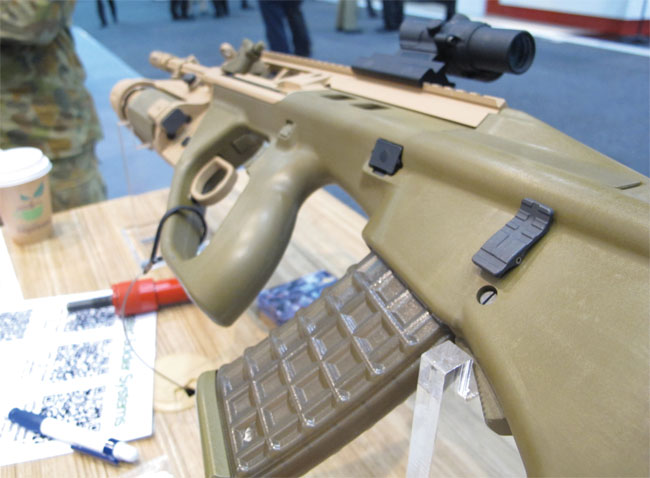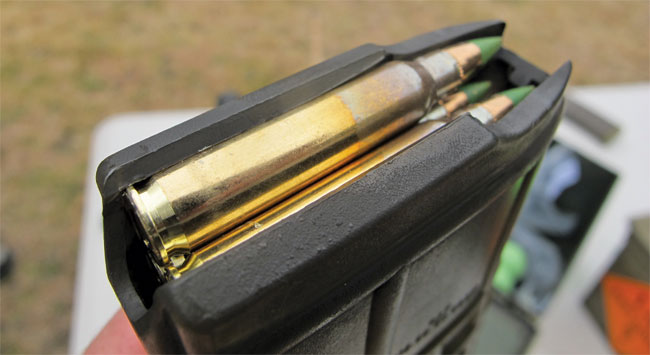ABOVE: EF88 with 16-inch barrel shown with Ase Utra suppressor, Trijicon TA44SR-10 1.5×16 ACOG, and folding foregrip.
In September, this author had the opportunity to visit Lithgow (New South Wales, Australia) at the invitation of Thales Australia in order to conduct a Test and Evaluation (T&E) of their Enhanced F88 Assault Rifle. This weapon is being developed for the Australian Defence Force (ADF) under the Land 125 Phase 3C program. Pending the results of Department of Defence testing, this rifle will be in the early stages of manufacturing in 2013. A version of the EF88, with several minor differences, is being marketed globally by Thales as the F90, drawing directly on the Australian small arms experience. The EF88 is the latest iteration of the long-serving F88 Austeyr; this updated weapon has been designed and produced more than 20 years after the first F88 rifles entered service in Australia, and over 35 years since the Steyr AUG was first designed in Austria. Fundamentally, the EF88 remains much the same as its predecessors: a bullpup-configuration selective fire weapon, chambered for the 5.56x45mm NATO cartridge, short-stroke piston operated and firing from a closed bolt.

Despite core similarities, the EF88 features a number of improvements designed to make the weapon more user-friendly and more combat effective. Many of these changes were inspired by a combination of operational user input and Defence specifications, whilst others were entirely Thales Australia’s own concepts. In fact, Thales Australia made a corporate decision to exceed the specifications laid out by Defence in Land 125 and have upgraded their operations at Lithgow from ‘build-to-print’ manufacturing to encompass a true Original Equipment Manufacturer (OEM) capability.
A lot of the experience that made this possible was gained during the F88SA2 program. As some readers may be aware, the F88SA2 has actually been made in two different series. The F88SA2 first saw service in 2009 and sported a two-tone colour change, a longer upper rail, and a bespoke side bracket to allow the fitting of a Night Aiming Device (NAD) or flashlight. The 2009 series experienced a technical issue – occasionally failing to fully lock with a full magazine after being manually cocked. Many users had taken to only loading 28 or 29 cartridges in each magazine as a way of combating this issue. In 2010, Thales made a series of reliability enhancements to the F88SA2 executed through a series of tolerance changes, more stringent gauging, and minor design changes. This experience, both in updating the F88 and F88SA1 to F88SA2 standard, as well as in refining manufacturing processes for the F88SA2 2010 series, has contributed to Thales Australia’s capability to produce a new assault rifle that significantly exceeds Defence’s stated requirements.

The differences between the EF88 and its predecessors are immediately noticeable. The redesigned buttstock and additional Mil-Std 1913 (Picatinny) accessory rails are the most obvious changes. The stock has been redesigned with ergonomics in mind, with a raised portion allowing for better cheek weld when firing. The redesign of the trigger guard allows for the integration of a new, purpose-designed Grenade Launcher Assembly (GLA). The buttplate is now made from a different polymer, ribbed to provide a positive grip on the shoulder, the folding foregrip is gone, the top accessory rail has been lengthened, and additional rails have been added to the underside and right-hand side of the weapon to accommodate the many ancillary devices currently in use. The additional rail added to the right hand side of the weapon, as well as the cocking guide on the left, are made from a high-strength polymer, further lightening the rifle. The receiver has been modified to reduce mass, which not only lightens the weapon (an EF88 with a 20-inch barrel is over half a kilo lighter than the current-issue F88SA2), but shifts the centre of gravity rearward, closer to the pistol grip. The net effect is a weapon that is not only lighter, but feels significantly more balanced and is easier to manipulate.
The barrel of the EF88 is produced in Lithgow on Thales’ cold hammer forging machine – the only one in the Southern Hemisphere – and has been fluted to reduce mass, increase rigidity, and allow for better heat dispersion. The EF88’s barrel is now fixed, and no longer needs to be removed whilst inspecting a weapon, as was the case with earlier F88 models. Thales will demonstrate the EF88 to Defence in both a 16-inch and 20-inch barrel configuration, though Defence will almost certainly select the 20-inch variant, as outlined in their specifications. The modified gas plug can now be adjusted by using a fired 5.56×45 cartridge case, and the cocking handle now folds upwards when desired. The hammer pack has been modified to prevent rifle stoppages as a result of firing the GLA, and the ejection port has been extended by 4mm, reducing the number of FTEs (Failures To Extract) caused by trapped fired cases experienced by the operator. The ejection port covers have also been redesigned, making them less vulnerable to damage when fitting and removing, and less likely to work loose after prolonged firing. The two-stage progressive trigger has been retained, requiring a 2.5 kg pull for semiautomatic, and 5.0 kg for automatic fire. The ADF version will still be fitted with an ALO (Automatic Lock Out) feature seen on previous models, which can be engaged to prevent automatic fire. The EF88 is interoperable with all ammunition types manufactured in accordance with NATO specifications. Testing was conducted with F1, F1A1, M855, SS109, M856, and F3A1 cartridges, with the weapon performing satisfactorily with all cartridges tested. The F1A1 cartridge has an optimised projectile (modified boat tail length and meplat diameter), a redesigned cartridge case, and utilises Thales’ new AR2210V01 propellant.
A new GLA (Grenade Launcher Assembly) has been designed, in consultation with Thales Australia, specifically for the EF88. The Madritsch Weapon Technology ML40AUS is manufactured from a lightweight combination of steel, aluminium, and synthetic materials, making it one of the lightest underbarrel grenade launchers on the market at less than one kilo. An EF88 with a 20-inch barrel and ML40AUS GLA is more than 1.6kg lighter than the equivalent F88SA2 with current-issue RM Equipment M203PI GLA. The GLA is also integrated with the EF88, mounting directly to the bottom accessory rail. A removable plug conceals an opening that allows the launcher’s trigger to sit within the trigger guard of the rifle itself. This results in the weight of the launcher sitting further from the muzzle, and much closer to the rifle’s point of balance, significantly improving the handling characteristics of the system. The ML40AUS is different from the current-issue M203PI GLA in a number of other ways. It features a side-opening breech, compatible with longer 40x46mm cartridges including less-lethal and illumination rounds, as well as a cross-bolt safety, very similar to that on the EF88 itself, which should help with cross-platform familiarity and training. Thales Australia has also designed a new quadrant sight to complement the GLA. Unlike the Knight’s Armament Company quadrant sight assembly currently in use, Thales’ new design mounts to the top accessory rail, and sits neatly alongside optics such as the Trijicon ACOG series.

All of this sounded good in practice; however we were eager take the EF88 to the range and put it through its paces. Thales provided the three of us shooting with over two thousand rounds of F1A1 ball, and around twenty 40x46mm cartridges (a mix of Rheinmetall practice marker rounds and M1006 less-lethal ‘sponge’ rounds). Thales’ 600m range is located adjacent to their Lithgow production facility, bordered by steep earth and stone embankments, and set back into the eucalypt forest. We were in for a crisp, cool day with a slight shifting wind that dropped off later in the afternoon. Thales provided us with two EF88 rifles, featuring 16-inch and 20-inch barrels, as well as a current-issue F88SA2 for comparison. The 20-inch EF88 was fitted with the ML40AUS GLA and Thales’ new quadrant sight, a 4x ACOG, and (later) a Harris bipod. The 16-inch version was presented with a 1.5x ACOG, rail-mounted folding foregrip, and a four-prong threaded flash hider. This was used in conjunction with an Ase Utra suppressor, and will be available as an option on the F90. The F88SA2 had the current-issue M203PI GLA and Knight’s Armament quadrant sight fitted.

The superior ergonomics and point of balance were immediately noticeable, with both EF88s being significantly more comfortable to manipulate than their predecessors. The 16-inch variant was particularly easy to handle and comfortable to manipulate with one hand. The cheek weld was markedly better than on current-issue weapons, and made accurate shooting at range a lot more practical. We engaged targets at 25, 50, 100, and 600 metres, as well as firing grenades out to 150 metres, and found the rifle and GLA to be comfortable and easy to handle at all of these distances. Magazine changes were identical to current practice (users will already know not to ‘slap in’ magazines, as you would for many other rifles), however Defence has now specified that future EF88s will be fitted as standard with a bolt catch release, which should speed up magazine changes. This feature is also standard on all F90 assault rifles. Despite the EF88’s retention of the two-stage, progressive trigger (with long, reasonably heavy trigger pull), we managed to produce surprisingly good results out to 600 metres.
Whilst the weapon was comfortable, accurate, and generally reliable, it is worth noting that we experienced two light strikes over the day’s firing. Both of these occurred when firing the suppressed 16-inch EF88. Thales have informed me that “firing with the suppressor was exploratory at that time; optimisation will be conducted early next year.” Despite these failures, the EF88 has been assessed to have a MRBS (Mean Rounds Between Stoppages) rate and MRBF (Mean Rounds Between Failure) rate that are both very impressive. Unfortunately, this data cannot be published just yet, but the numbers show it to be a very reliable rifle.

It was clear that the EF88 is significantly better than its predecessors, and exhibits all of the traits of a competitive modern assault rifle. Within its niche as an advanced bullpup rifle, it has little competition – perhaps only from the IMI Tavor series – and exceeds the standards provided by Defence under Land 125. Thales Australia have managed to correct some of the weaknesses of the F88SA2 (poor cheek weld, excessive weight, etc.) with the EF88, and have taken further steps with the F90, with the addition of a bolt catch release, optional compatibility with NATO (AR-15 style) magazines, and a flash hider that is threaded to accept a suppressor. The ML40AUS GLA performed admirably; both it and the Thales-designed quadrant sight were a substantial improvement over the current-issue kit, with the trigger integration and superior system balance of particular note. Thales Australia have built on their experience conducting the Factory Thorough Rebuild (FTR) program upgrading F88 and F88SA1 rifles to F88SA2 standard, and have clearly transitioned to a true OEM capability. The Enhanced F88 Assault Rifle is the culmination of this process, and comes in the 100th year of arms manufacturing in Lithgow. With rifles like this, there may well be another hundred ahead.
(The author would like to thank Thales Australia for their hospitality & support in producing this review. It should be noted that Thales paid for the accommodation and meals of the author during the review period. The views in this article are those of the author only, & do not necessarily represent those of Thales Australia or the Australian Department of Defence.)










